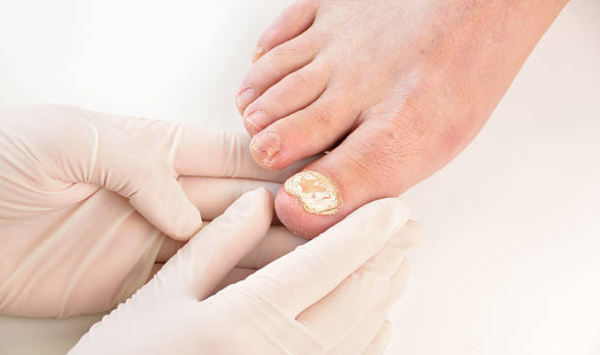Nail ringworm is a very common problem. Its incidence is higher in adults over 40, people with diabetes, HIV, poor peripheral blood circulation, obesity or any immunosuppression.
It usually starts with yellow or whitish spots on the nails. Sometimes they leave the nails discolored, brittle, stiff, but usually don't cause pain.
Most people, for not feeling pain or not bothering with the appearance of their nails, end up not seeking treatment for nail fungus.
Lack of treatment is harmful because, in addition to infecting others, the disease can get worse, especially if you have a condition of low immunity or illnesses such as diabetes. However, when treated early, the ringworm regresses more quickly and you will have your nails healthy again in no time.
In addition, there are other changes and diseases of the nails that can be confused with mycoses, which is one more reason for seeking an early diagnosis. So let's understand how you can identify ringworm and what you need to do about it.
-> Also read: "Why do elderly and diabetics have more ringworm and are more difficult to treat?"
What is ringworm?
Ringworm is a generic term that refers to yeast infection. There are more than 250,000 fungi in nature. Of these, about 200 are capable of causing ringworm. Fungi can be found in the air, soil, water, decayed trunks, vegetables, fruits.
When the fungi that infect our bodies are able to reproduce in a way that our bodies cannot control, they can cause fungal infections, hence, mycoses.
Mycoses can affect various parts of the body, such as the outermost layer of skin, hair and nails, as well as deeper parts, spreading through the blood or lymphatic circulation to internal organs such as lungs, intestines, bones, system nervous etc.
In this article, we will understand a little more about nail fungus, specifically.
What is ringworm of the nail, what are its signs and symptoms, how to make the diagnosis and what is the treatment?
What is ringworm of the nail?
A fungal infection of the nail – and surrounding tissue – is known as “Onychomycosis”. It can be caused by groups of fungi called yeasts, by non-dermatophyte fungi, and especially by dermatophyte fungi.
This is because dermatophyte fungi are those that use keratin (a protein present in the skin, hair and nails) to carry out their vital functions.
Therefore, they are the main agents of onychomycosis, especially in the toenails.
What are the signs of onychomycosis (nail mycosis)?
The most common signs of onychomycosis (nail mycosis) are:
- Variation in nail color, which becomes whitish and/or acquires yellowish or dark tones;
- Detachment of the free edge that starts at the corners of the nail and leaves a hollow space under the nail, where fungi, bacteria and keratin residues accumulate;
- Thickening – nails become harder, thicker and opaque;
- White spots on the surface of the nail;
- Nail destruction and deformities as they become more brittle and brittle.
However, these changes in the nails can also occur motivated by other infectious agents, such as bacteria and viruses, resulting from systemic, congenital, endocrine diseases, nutritional deficiencies, trauma, drug use, among others, as we will see below.
Therefore, be careful not to confuse onychomycosis (nail fungus) with other diseases.
Diseases that may be confused with Onychomycosis - Nail Mycosis
See some diseases that present changes in the nails, similar to those caused by onychomycosis (nail mycosis):
- Nail psoriasis: the nails may present alterations such as punctiform depressions, spots (localized areas, with light brown pigmentation), detachment of the nail part of the nail bed, thickening and crumbling of the nail;
- Benign and malignant tumors: affect the nail causing deformities. Melanoma, a rare but very aggressive malignant tumor, manifests itself in brown to black spots, which can invade the skin region around the nail;
- Thyroid disorders, hormonal and vitamin deficiencies in the elderly: can leave nails fragile and brittle;
- Bacterial infections (Pseudomonas): They cause green nail syndrome, an infection that is characterized by the presence of blue-green spots on the nails. It usually occurs in patients with nail detachment from the bed or chronic paronychia (infection of the region around the nail), whose nails are immersed in water for a long period;
- Trauma: can lead to the formation of subungual hematoma (under the nail), bluish-black pigmentation, causing significant and throbbing pain;
- Alopecia areata: A disease that causes hair to suddenly fall out, leaving uneven rounded shapes, and can also make the nails rough and dull, with the appearance of sandpaper.
Due to the difficulty in distinguishing the signs of a ringworm and other diseases or disorders, the diagnosis can only be made through laboratory tests.
Correct diagnosis of onychomycosis (nail mycosis): mycological examination
The preparation of the patient and the collection of subungual scales (under the nails) for mycological examination are essential for obtaining the correct diagnosis and success in the therapeutic management of nail mycoses.
Get to know the guidelines for carrying out the mycological exam.
The patient must discontinue the use of any oral (for at least one month) and topical (for one week) antifungal medications before performing the exam.
Nor can you cut, clean or paint with enamel or base nails to be examined.
During the exam:
- The regions from which the samples will be collected must be cleaned with gauze or cotton with 70% alcohol, to eliminate superficial bacterial contaminants;
- The fragments of altered nails can be collected by scraping them with a scalpel or with the aid of clean scissors;
- The material that is deposited under the nail can be carefully removed with a scalpel, with a toothpick (type of manicure), or other sharp object, always previously sterilized. Try to penetrate well and always harvest in the border region between the healthy part and the part affected by the fungus, as this is the place where the viable fungal structures for the laboratory examination are;
- Always discard the outermost scales or the most superficial material, as they are contaminated with dust.
The mycological examination, which includes direct examination and culture, will identify the fungus that is causing the mycosis and the dermatologist or podiatrist will be able to indicate the efficient treatment.
How to treat ringworm in the nail
The treatment to be indicated by the podiatrist, physician or specialist depends on each patient's condition. The treatment time for toenail fungus is usually around 6 to 12 months, but it also varies according to the conditions and the individual's body.
It usually involves monthly visits to a podiatrist to trim the nail properly and remove the accumulation of dead cells that feed the fungus. Oral or topical antifungal medications, treatments such as Ozone Therapy and Laser Therapy, may also be prescribed.
The treatment must be followed to the letter, for the time indicated by the podiatrist or doctor, even if the signs and symptoms seem to have “disappeared”. Sometimes these signs and symptoms go away before the disease is completely cured.
How to prevent ringworm on the nail
Since it is always better to be safe than sorry, know that observing some hygiene habits are the most important factors in preventing ringworm. Always remember:
- After showering, carefully dry hands and feet, including between the toes.
- Avoid walking barefoot or wearing sandals in places that are always damp, such as changing rooms, saunas and swimming pool feet washes;
- Do not wear closed shoes for long periods and opt for wider and ventilated shoes, with material that allows your feet to “breathe”;
- Bring your own material when you go to the manicure, such as pliers, files and nail sticks, and do not use artificial nails.
If you still have any questions about mycoses, or want to know more tips and information about podiatry, visit our blog or get in touch!
-> Read also: "bunion: what it is, how to prevent and the importance of footwear."






